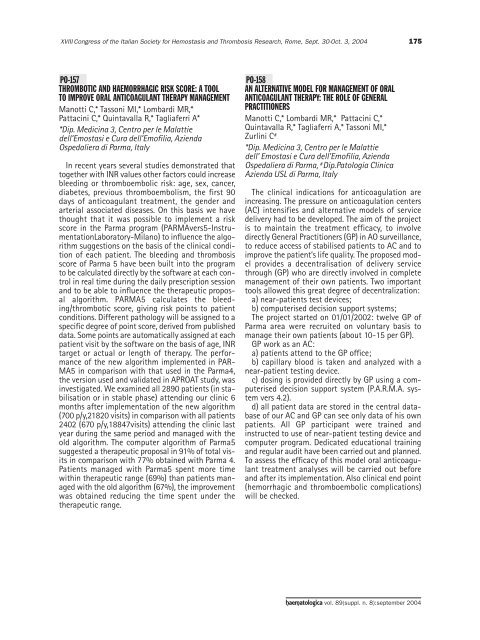Haematologica 2004;89: supplement no. 8 - Supplements ...
Haematologica 2004;89: supplement no. 8 - Supplements ...
Haematologica 2004;89: supplement no. 8 - Supplements ...
- No tags were found...
You also want an ePaper? Increase the reach of your titles
YUMPU automatically turns print PDFs into web optimized ePapers that Google loves.
XVIII Congress of the Italian Society for Hemostasis and Thrombosis Research, Rome, Sept. 30-Oct. 3, <strong>2004</strong>175PO-157THROMBOTIC AND HAEMORRHAGIC RISK SCORE: A TOOLTO IMPROVE ORAL ANTICOAGULANT THERAPY MANAGEMENTMa<strong>no</strong>tti C,* Tassoni MI,* Lombardi MR,*Pattacini C,* Quintavalla R,* Tagliaferri A**Dip. Medicina 3, Centro per le Malattiedell’Emostasi e Cura dell’Emofilia, AziendaOspedaliera di Parma, ItalyIn recent years several studies demonstrated thattogether with INR values other factors could increasebleeding or thromboembolic risk: age, sex, cancer,diabetes, previous thromboembolism, the first 90days of anticoagulant treatment, the gender andarterial associated diseases. On this basis we havethought that it was possible to implement a riskscore in the Parma program (PARMAvers5-InstrumentationLaboratory-Mila<strong>no</strong>)to influence the algorithmsuggestions on the basis of the clinical conditio<strong>no</strong>f each patient. The bleeding and thrombosisscore of Parma 5 have been built into the programto be calculated directly by the software at each controlin real time during the daily prescription sessionand to be able to influence the therapeutic proposalalgorithm. PARMA5 calculates the bleeding/thromboticscore, giving risk points to patientconditions. Different pathology will be assigned to aspecific degree of point score, derived from publisheddata. Some points are automatically assigned at eachpatient visit by the software on the basis of age, INRtarget or actual or length of therapy. The performanceof the new algorithm implemented in PAR-MA5 in comparison with that used in the Parma4,the version used and validated in APROAT study, wasinvestigated. We examined all 2<strong>89</strong>0 patients (in stabilisatio<strong>no</strong>r in stable phase) attending our clinic 6months after implementation of the new algorithm(700 p/y,21820 visits) in comparison with all patients2402 (670 p/y,18847visits) attending the clinic lastyear during the same period and managed with theold algorithm. The computer algorithm of Parma5suggested a therapeutic proposal in 91% of total visitsin comparison with 77% obtained with Parma 4.Patients managed with Parma5 spent more timewithin therapeutic range (69%) than patients managedwith the old algorithm (67%), the improvementwas obtained reducing the time spent under thetherapeutic range.PO-158AN ALTERNATIVE MODEL FOR MANAGEMENT OF ORALANTICOAGULANT THERAPY: THE ROLE OF GENERALPRACTITIONERSMa<strong>no</strong>tti C,* Lombardi MR,* Pattacini C,*Quintavalla R,* Tagliaferri A,* Tassoni MI,*Zurlini C #*Dip. Medicina 3, Centro per le Malattiedell’ Emostasi e Cura dell’Emofilia, AziendaOspedaliera di Parma, # Dip.Patologia ClinicaAzienda USL di Parma, ItalyThe clinical indications for anticoagulation areincreasing. The pressure on anticoagulation centers(AC) intensifies and alternative models of servicedelivery had to be developed. The aim of the projectis to maintain the treatment efficacy, to involvedirectly General Practitioners (GP) in AO surveillance,to reduce access of stabilised patients to AC and toimprove the patient’s life quality. The proposed modelprovides a decentralisation of delivery servicethrough (GP) who are directly involved in completemanagement of their own patients. Two importanttools allowed this great degree of decentralization:a) near-patients test devices;b) computerised decision support systems;The project started on 01/01/2002: twelve GP ofParma area were recruited on voluntary basis tomanage their own patients (about 10-15 per GP).GP work as an AC:a) patients attend to the GP office;b) capillary blood is taken and analyzed with anear-patient testing device.c) dosing is provided directly by GP using a computeriseddecision support system (P.A.R.M.A. systemvers 4.2).d) all patient data are stored in the central databaseof our AC and GP can see only data of his ownpatients. All GP participant were trained andinstructed to use of near-patient testing device andcomputer program. Dedicated educational trainingand regular audit have been carried out and planned.To assess the efficacy of this model oral anticoagulanttreatment analyses will be carried out beforeand after its implementation. Also clinical end point(hemorrhagic and thromboembolic complications)will be checked.haematologica vol. <strong>89</strong>(suppl. n. 8):september <strong>2004</strong>
















